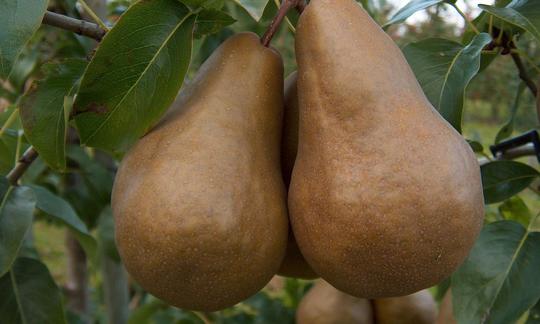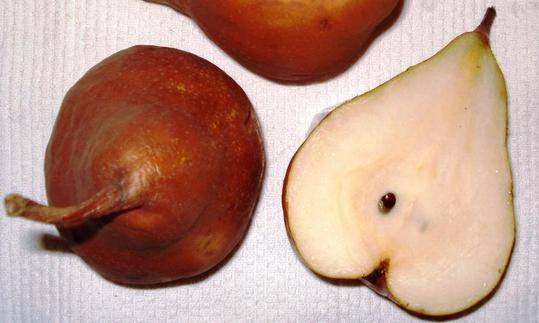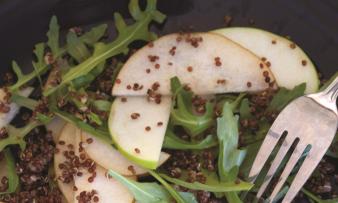Table of contents
Bosc's bottle pear belongs to the pome fruit family. Along with apples, pears are one of the most popular types of fruit in Europe, especially in organic quality. The fruit is rich in health-promoting substances and can be eaten raw , dried, cooked or preserved.
Use in the kitchen
Boscs pears have a rough, greenish-yellow skin with a yellow-brown "russeting". The juicy flesh is whitish-yellow and tastes very sweet and soft. Raw Boscs bottle pears are ideal for eating straight away (table pears). With a height of 9-11 cm and a diameter of 5-7 cm, they are one of the medium to large pear varieties.
Pears can be used in many different raw food dishes, for example in fruit salad, as a topping for muesli (for example in pea muesli as a substitute for apple ), as a fruity addition to smoothies with spinach or in home-made juices. Cooked pears or pear puree refine porridge, vegan rice pudding and semolina pudding, among other things. Pears also taste particularly good in combination with cinnamon or cardamom ; you can make them into a chutney with these spices or bake them (for example with walnuts ) and serve them as a dessert. Other tasty dessert options with pears are a baked crumble with oatmeal or cake. Dried pears can also be found in bread and pastries.
The sweet pears add a special touch to raw salads. They go perfectly with sweet salads such as Batavia lettuce andlettuce , but also taste delicious with slightly bitter or spicy salads such as chicory and rocket . A balsamic-Dijon dressing goes well with them.
Vegan recipe for pear and banana ice cream
Ingredients (for 4 people): 1 banana , 1-2 Boscs bottled pears, 3 tbsp macadamia nuts , 100 ml oat drink , 2 pinches ofvanilla powder .
Preparation: Peel the bananas and cut into slices. Peel the pears and cut into pieces. Freeze the bananas and pears. Put the frozen bananas and pears, macadamia nuts, oat milk and vanilla powder in a container and quickly mix with a high-performance blender to form a creamy ice cream mixture. Arrange the raw ice cream in small bowls and serve immediately.
Vegan recipes with Bocs bottle pears can be found under the note: " Recipes that have the most of this ingredient ".
| Not only vegans or vegetarians should read this: Vegans often eat unhealthily. Avoidable nutritional errors . |
Purchasing - Storage
Most of the pear varieties cultivated in Europe have their main season in autumn, including the Bocs bottle pear. Harvest time is from mid-September to October . 3
Where can you buy Boscs bottle pears? Boscs are a popular pear variety in the DA-CH region and are available seasonally from major retailers such as Coop , Billa , Migros , Denner , Volg , Spar , Aldi , Lidl , Rewe , Edeka and Hofer . Alnatura and Denn's Biomarkt stock them in organic quality. You can also buy the bottle pear seasonally on farms or at weekly markets.
When buying pears, remember that they ripen from the inside out. This means that when the skin begins to ripen, the inside may already be overripe and mealy. Ideally, fresh pears should not have any bruises or holes.
The availability of Bosc's bottle pears varies depending on the size of the store, catchment area, etc. Our recorded food prices for the DA-CH countries can be found above under the ingredient image - and by clicking on them you can see their development at various suppliers.
Storage tips
Pears are primarily produced for direct consumption, as they are difficult to store. 2 Compared to apples , which can be stored for up to a year, pears spoil more quickly and only selected varieties last more than a few months. They should be stored in a cool, dark place without touching each other. 7
The Boscs bottle pear has a limited shelf life, which is why it should be consumed quickly. Since pears are climacteric fruits, they continue to ripen after harvest. Alternatively, pears can also be frozen. To do this, wash, cut and core the fruit and then store it in a freezer bag at -18°C for up to 10 months.
Ingredients - Nutritional values - Calories
Raw Boscs bottle pears (organic?) consist of up to 83% water, the energy content is 67 kcal per 100 g. Proteins and fat are poorly represented among the nutrients, the main component of energy comes from carbohydrates (16 g/100g), of which 10 g is sugar. The fiber content is 3.1 g per 100 g. 1
Boscs are a good source of potassium , an important element for the body's water balance, with 122 mg/100g. Fruits with similar levels of this essential element are apple (Granny Smith) and sea buckthorn berries . Foods that have a much higher potassium content are dried tomatoes (3427 mg), dried porcini mushrooms (2000 mg) and soybeans (1797 mg/100g). 1
They contain relatively small amounts of vitamins - for example vitamin K (5.2 µg/100g) or vitamin C (2.8 mg/100g). Folate (folic acid) is also included at 7.0 µg/100g. 1
You can find the complete ingredients of Bosc's bottle pears, the coverage of the daily requirement and comparison values with other ingredients in our nutrient tables .
Effects on health
Fruits are part of a healthy diet due to their concentration of vitamins, minerals, secondary plant substances and fiber. However, there are only a few clinical studies to date on the health value of the cultivated pear ( Pyrus communis ), which also includes the Boscs bottle pear. Epidemiological studies rarely distinguish between apples and pears because they are botanically related and have similar nutrient profiles, so there is little data here either. 13
Pears contain secondary plant substances whose antioxidant and anti-inflammatory effects can reduce the risk of cancer or cardiovascular disease. However, the content of secondary plant substances varies depending on the pear variety. Data for the Boscs variety are not yet available. 13,14,15,16
Most of the important ingredients are found in the pear's skin. That's why you should prefer organic pears, which can be eaten with the skin after washing. 13 Studies also show that organically grown pears have a higher content of polyphenols and alpha-tocopherol than conventionally grown pears. When grown organically without pesticides, the plant has to protect itself, which is why the antioxidant defense system improves and the secondary plant substances increase. 17
Dangers - Intolerances - Side effects
Eating pears can cause allergic reactions. In northern Europe, this usually affects people who also have allergic reactions to birch pollen. Local symptoms such as a scratchy mouth and throat occur 5 - 15 minutes after consumption. The allergen involved can be rendered ineffective by cooking beforehand. In Mediterranean countries, however, an allergic reaction to pears occurs as a cross allergy to peaches. The possible symptoms are far more serious in this form, with stomach pain, vomiting or life-threatening conditions. 8
Pears are rich in fructose and sorbitol, which is why eating large amounts can cause diarrhea. 13
Folk Medicine - Natural Medicine
In China, pears are used in traditional folk medicine due to their anti-inflammatory, anti-hyperglycemic and diuretic properties. Other traditional uses of pears include use as a cure for alcohol hangovers, to relieve coughs and constipation. 13
Ecological footprint - animal welfare
When studying the ecological balance, no distinction is often made between the individual pear varieties.
The ecological CO 2 footprint of regional pears is 0.3 kg CO 2 eq/kg, similar to that of regional apples or grapes, for example. 10 Imported pears from other continents, on the other hand, do rather poorly in the assessment of the climate effect due to the high amount of CO 2 during transport by ship. 11 The amount of water required to produce 1 kg of pears is 922 liters. 12
In conventional agriculture, synthetic pesticides and herbicides are often used to combat pests. However, the impact of these agents is not limited to individual plants; they also have a negative effect on their surroundings. In addition, they can sometimes be found in the end product; high levels of residues of various pesticides have been found, particularly in fruit. To avoid pesticides in food, it is better to use organically grown fruit and vegetables, as the use of synthetic pesticides is prohibited here.
Animal protection - species protection
During the flowering period, the pear tree is dependent on insects such as wild bees or honey bees for pollination, as its flowers are self-sterile. However, pear blossoms are not as attractive as, for example, apple or apricot blossoms due to both the low amount of nectar and the chemical composition of the pollen. 4
However, there are differences between the individual pear species, which can play a major role in the selection of species for plantations. A study in China showed that both the native Asian honey bee ( Apis cerana ) and the European honey bee ( Apis mellifera ) visited the flowers of the European cultivated pear ( P. communis ) more frequently to search for food than the Chinese white pear ( P. bretschneideri ). When growing pears, one should avoid planting 'exotic pear varieties' (especially in Europe), as the cultivated pear ( P. communis ) is a better source of food for bees.
Worldwide occurrence - cultivation
The exact origin of the Boscs variety ( Pyrus communis Boscs bottle pear) is thought to be in Belgium or France at the beginning of the 19th century. The name goes back to the director of the botanical garden in Paris, Boscs.
The origin or gene center of the current pear genus ( Pyrus ) is not clearly established. In addition to China, it could also be in the region of Asia Minor and the Middle East. Of the 23 catalogued wild pear species, all are native to Europe, the temperate zones of Asia and North Africa. 5
The pear was cultivated in China, as well as in Asia Minor, the Middle East, the Caucasus and Central Asia. 5
Worldwide, the pear is the third most important fruit variety in the temperate climate zone after grapes and apples. 2 According to FAOSTAT , 26.32 million tons of pears were produced worldwide in 2022. The main producing countries are China (19.26 million tons), the USA (584,230 tons), and Argentina (566,227 tons). 9
Growing in your own garden - harvest
Like other varieties of cultivated pears ( Pyrus communis ), the Boscs pear needs deep, well-drained and nutrient-rich soil. When choosing a location, you should also make sure that the tree is as sheltered as possible, but still receives plenty of direct sunlight. Ideally, the young tree should be planted in late autumn (October/November), so that it has enough time for roots to grow over the winter. To plant it, first dig a sufficiently large planting hole and partially fill it with fresh and compost soil. After planting the pear tree, it is advisable to also attach a support post to which the young tree can be tied. Water the freshly planted tree well and, if necessary, protect it from other plants with a coconut mat. During the first few years, you can support the tree's growth by adding additional water. 6
When is the harvest time for Bosc's bottle pears? The bottle pear can be picked from mid-September, although it is not ready to eat until October. The fruit should be harvested while still slightly hard, as ripe fruit usually falls from the tree. 3
Further information
Bosc's bottle pear is a variety of the European cultivated pear ( Pyrus communis L.). This belongs to the pear genus ( Pyrus ), which contains 22 species and other varieties. These can pollinate each other and form hybrids. 2 Other well-known species are the Chinese pear ( Pyrus calleryana 'Chanticleer' ) or the Pyrus pyrifolia Nakai , known as the Nashi pear .
The pear belongs to the pome fruit family (Pyrinae) in the rose family (Rosaceae). Other well-known pome fruits are: apple ( Malus ), chokeberries ( Aronia ), quince (Cydonia) and medlar ( Mespilus ).
Alternative names
Boscs bottle pear is also often called Kaiser Alexander, Calebasse Boscs, Kaiserbirne, Alexanderbirne and Kaiserkrone.
Imperial crown is also used for the Princess Marianne variety. They look similar, but the stem of the Boscs is shorter and does not have a bulge on the fruit. The Boscs also ripens later and has a different taste. 3
The English name is bosc pear or Beurre Bosc pear. Beurre refers to the French beurré (butter), which refers to the buttery, soft flesh of the fruit.











Comments